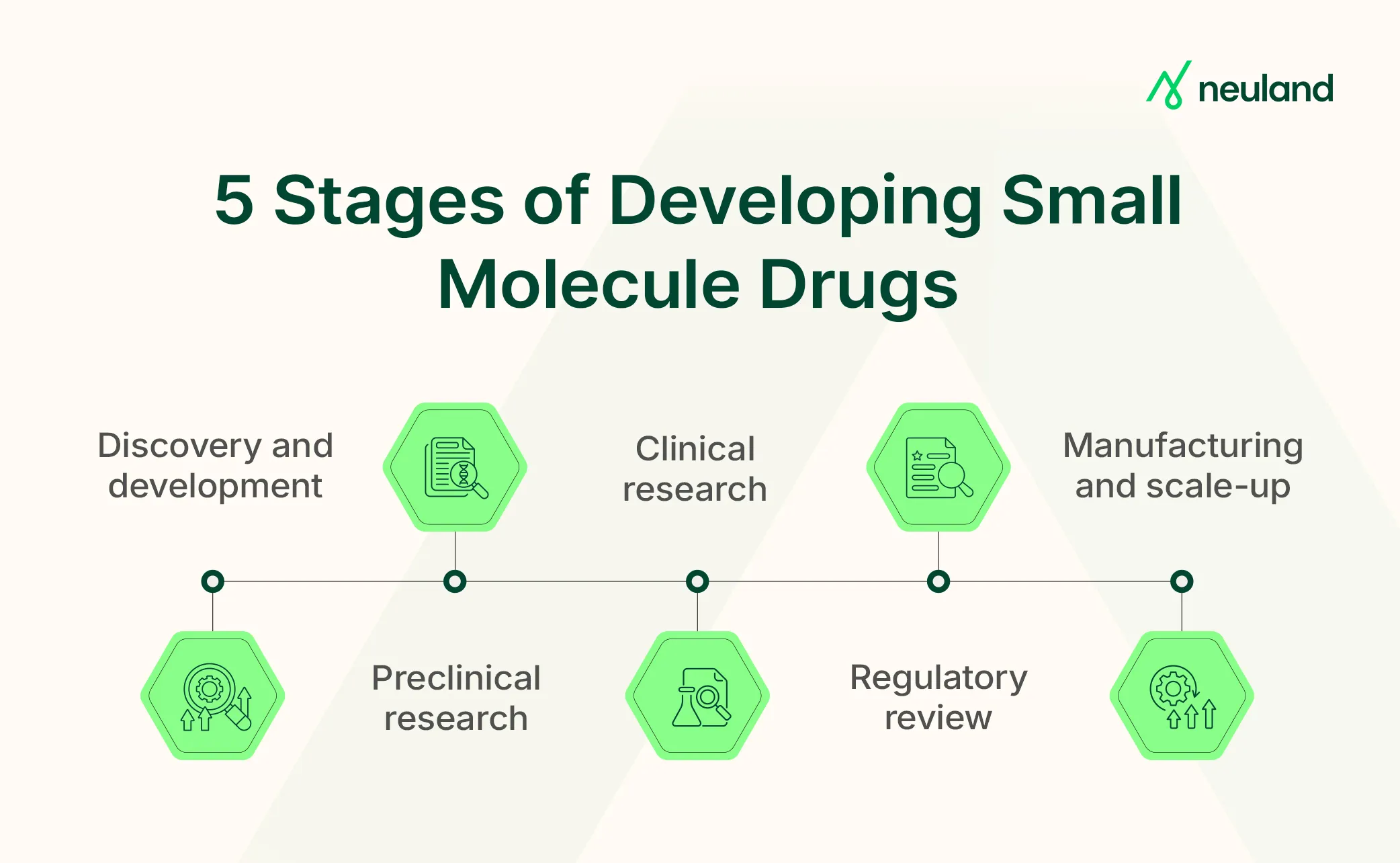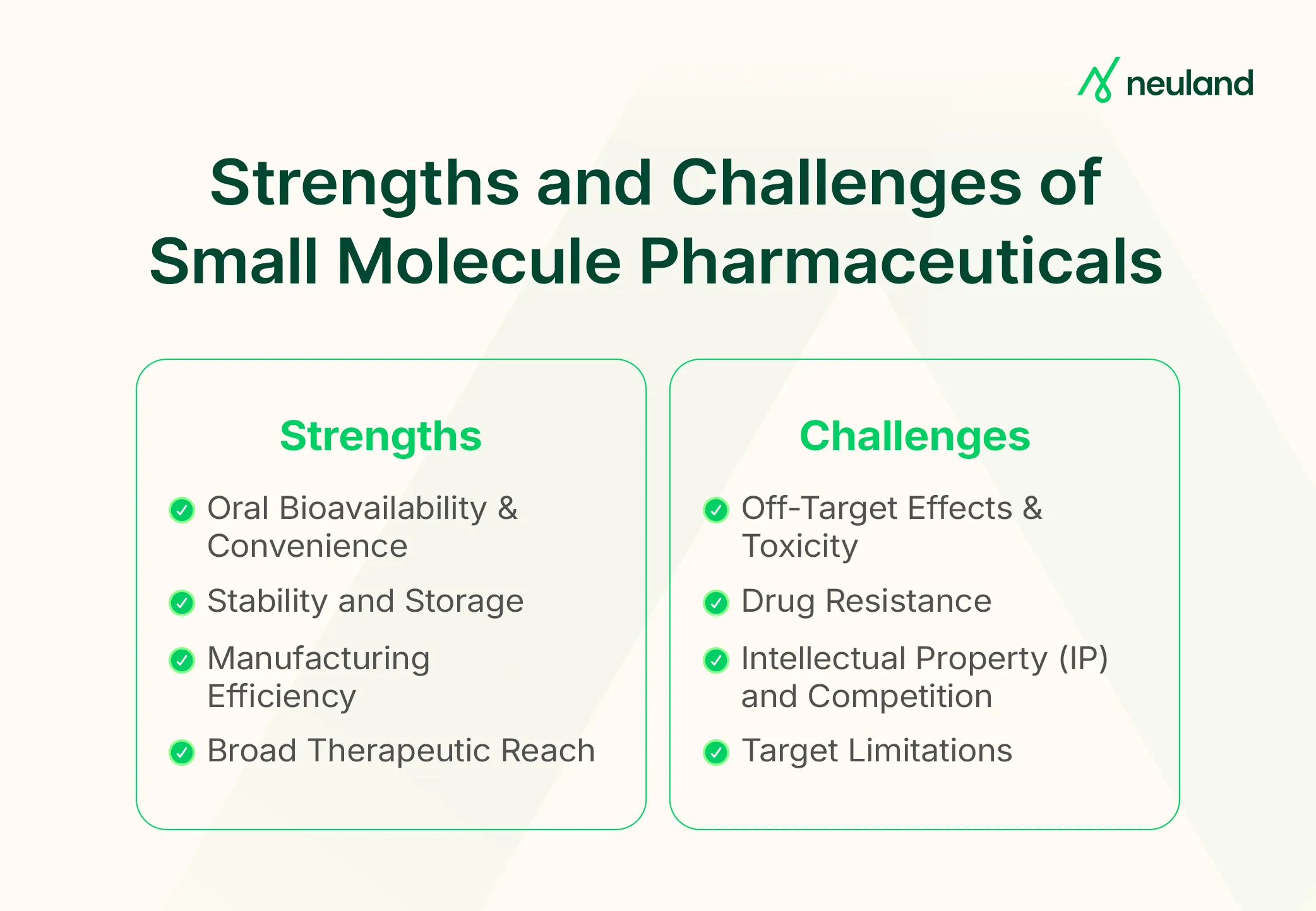Small Molecule Drug Development: Process, Strengths, and CDMO Role
From pain relievers to cancer therapies, small-molecule compounds have long been the foundation of modern medicine.
These compounds, typically with a molecular weight under 900 Daltons, are chemically synthesized, easy to formulate as pills or capsules, and capable of targeting a wide range of diseases.
Small molecule development refers to the full journey of turning a promising chemical compound into an approved pharmaceutical product.
For pharmaceutical and biotech companies, understanding the fundamentals of small-molecule drug development is essential. Whether you're in early discovery or preparing for commercial launch, having the proper roadmap and the right CDMO can accelerate success.
5 Key Stages of Small Molecule Drug Development

Developing a small-molecule drug is a long, rigorous journey with several key stages. Each stage builds evidence of the drug’s safety, efficacy, and quality:
1. Discovery and Lead Optimization
Drug discovery for small molecules begins with identifying a biological target, such as an enzyme or receptor linked to a disease, and designing chemical compounds that can modulate that target.
Researchers screen libraries of compounds to find “hits,” then optimize those molecules’ properties (potency, selectivity, ADME profiles) through medicinal chemistry. The result is one or more lead candidates that are ready for further testing.
This small-molecule drug discovery phase can take several years of iterative design and testing to yield a viable candidate for development.
2. Preclinical Testing
In the preclinical stage, researchers assess pharmacokinetics, i.e., how the drug is absorbed, distributed, metabolized, and excreted.
The goal is to ensure the small molecule has an acceptable safety profile before giving it to humans. This involves assessing potential toxicological risks, such as mutagenicity or organ-specific toxicity, and determining safe and effective dosing parameters.
Successful completion of this stage is typically when an Investigational New Drug (IND) application is filed with regulators to authorize clinical trials.
3. Clinical Trials (Phases I–III)
Clinical development is the most resource-intensive part of small-molecule drug development. It is usually conducted in three phases:
- Phase I tests the drug in a small group of healthy volunteers or patients to assess safety and tolerability. For example, monitoring for adverse effects and determining a safe dosage range.
- Phase II expands to more patients and focuses on effectiveness for the target condition, while continuing to evaluate safety and refining the dose.
- Phase III consists of large-scale trials with hundreds or thousands of patients to confirm efficacy and monitor for rarer side effects statistically. Only a fraction of small-molecule candidates that enter clinical trials will successfully demonstrate a balance of safety and benefit to proceed to the next phase. Those that do succeed in Phase III can move on to seek regulatory approval.
4. Regulatory Review and Approval
If a small-molecule drug shows compelling results in clinical trials, the data are compiled into a New Drug Application (NDA) for regulatory review. This review process ensures the drug’s benefits outweigh its risks for the intended use.
A critical component of this evaluation includes Chemistry, Manufacturing, and Controls (CMC) information to confirm the compound can be consistently made at high quality. Upon a positive review, the drug is approved for marketing.
Upon regulatory approval, the drug receives market authorization. Post-approval, Phase IV studies (post-marketing surveillance) are conducted to track long-term safety or rare adverse events in the broader patient population.
5. Manufacturing and Scale-Up
An often underestimated but critical stage is small molecule manufacturing and scale-up.
Process chemistry teams optimize the synthetic route to be cost-effective and scalable from grams in the lab to kilograms or tons in a manufacturing plant. They also ensure purity and stability meet strict quality standards.
Small molecules typically offer an advantage, as their manufacturing is more straightforward “chemistry," as opposed to cultivating living cells for biologics. However, challenges can still arise in scaling reactions, controlling polymorphs, or improving yield.
Many companies engage specialized Contract Development and Manufacturing Organizations (CDMOs) to assist with process development and commercial-scale production.
Strengths and Challenges of Small Molecule Drugs
Small-molecule drugs have formed the backbone of medicine for decades. They offer notable strengths, but also come with challenges in development and use. Below is a summary of key advantages and drawbacks:

Strengths of Small Molecule Drugs
- Oral Bioavailability & Convenience: Most small-molecule drugs can be formulated as pills or capsules, allowing patient-friendly oral administration. Their small size means they can survive the digestive tract and be absorbed into the bloodstream.
- Stability and Storage: Small molecules are generally chemically stable, with long shelf lives at room temperature.
- Manufacturing Efficiency: Because they are made via standard chemical synthesis, production of small molecules can be scaled efficiently. Manufacturing costs per dose tend to be lower than for biologics. Established infrastructure, such as CDMOs, exists to produce them in large quantities.
- Broad Therapeutic Reach: Small molecules can often penetrate cells and tissues easily. They have proven capable in a wide range of diseases, from infections to metabolic disorders to cancers. A wealth of medicinal chemistry know-how and precedent exists, aiding design of new drugs in this class.
Challenges of Small Molecule Drugs
- Off-Target Effects & Toxicity: Small molecules typically interact not just with the intended target but sometimes with other biological pathways, which can lead to side effects or toxicity.
- Drug Resistance: Especially in areas like antibiotics or oncology, target organisms or cells can develop resistance to small molecules. Combating resistance requires continual innovation and often combination therapies.
- Intellectual Property (IP) and Competition: Small-molecule pharmaceuticals face intense competition once their patents expire. Generic drug manufacturers can relatively easily reproduce small molecules, leading to steep revenue drops, often losing the majority of sales within a year of patent expiration.
- Target Limitations: Some biological targets are challenging for small molecules to modulate. For example, protein interactions or extracellular targets might be beyond what a small molecule can do.
Despite these challenges, small molecules continue to thrive as a modality due to their pharmacological flexibility and the industry’s accumulated experience in discovering and developing them. Ongoing innovations are also addressing many of these issues.
Neuland Labs: A Trusted CDMO Partner in Small Molecule Development
Given the complexity and cost of small-molecule drug development, choosing the right partner is often critical. Partnering with an integrated CDMO has been shown to streamline the development timeline and mitigate risks through a one-stop solution.
Neuland Labs is an example of a CDMO with extensive expertise in small-molecule development services:
- 40+ years of experience
- FDA-inspected manufacturing sites
- Capabilities across pre-clinical and clinical development, scale-up, and commercialization
- Trusted partner for complex chemistries and global filings
With its long-standing expertise, Neuland Labs continues to enable innovators to bring life-changing medicines from bench to market, solidifying its role as a go-to partner in small molecule development and manufacturing.
FAQs
|
|
|
|